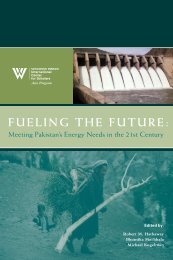Environmental Change and Security Project Report - Woodrow ...
Environmental Change and Security Project Report - Woodrow ...
Environmental Change and Security Project Report - Woodrow ...
You also want an ePaper? Increase the reach of your titles
YUMPU automatically turns print PDFs into web optimized ePapers that Google loves.
ty remains high—the population grows<br />
extremely rapidly, sometimes doubling in a<br />
single generation. Population growth is concentrated<br />
among youth, since the largest component<br />
of falling death rates is reduced infant<br />
<strong>and</strong> child mortality. This creates a substantial<br />
“youth bulge”—a disproportionate share of<br />
men <strong>and</strong> women in their teens <strong>and</strong> early twenties<br />
compared to mature adults. This baby<br />
boom often outpaces society’s ability to establish<br />
<strong>and</strong> staff schools, leading to inadequate<br />
education. Job markets also fail to keep up,<br />
reducing employment <strong>and</strong> social mobility of<br />
these large <strong>and</strong> often ill-equipped youth<br />
cohorts. Young men <strong>and</strong> their families, facing<br />
shortages of cropl<strong>and</strong> <strong>and</strong> water, flock to cities<br />
seeking employment, leading to an urban<br />
explosion. Thus, early transition societies<br />
often suffer from a surplus of unemployed<br />
youth, chaotic <strong>and</strong> overgrown cities, <strong>and</strong><br />
shortages of renewable resources—the conditions,<br />
according to Cincotta et al., that make a<br />
developing society prone to conflict.<br />
Although this is highly plausible <strong>and</strong> seems<br />
consistent with recent civil conflicts, which<br />
have mostly occurred in early <strong>and</strong> middle-stage<br />
countries, it is difficult to prove that demographic<br />
factors are really the causal determinant<br />
of conflict. Other scholars have argued that economic<br />
growth, stable currency, <strong>and</strong> strong<br />
investment can absorb labor surpluses <strong>and</strong><br />
encourage people to invest in education <strong>and</strong><br />
training; thus, strong economic performance<br />
can trump demography. In addition, good governance<br />
(e.g., low levels of corruption, stable<br />
<strong>and</strong> secure property rights) can enable societies<br />
to cope with rapid population growth, attracting<br />
investment <strong>and</strong> directing it where needed. 2<br />
More negatively, a strong authoritarian government<br />
can contain social tensions <strong>and</strong> prevent<br />
civil conflict, as demonstrated by the long corrupt<br />
reigns of Suharto in Indonesia, Mobutu in<br />
Zaire, Moi in Kenya, <strong>and</strong> many others. Since<br />
the number of countries in the early or middle<br />
stages of the democratic transition with strong<br />
economies or good governance is small, it is<br />
nearly impossible to disentangle these factors<br />
through statistical analysis.<br />
To their credit, Cincotta et al. have chosen a<br />
simple method that addresses most of these<br />
problems. It is not technically sophisticated—<br />
quite the reverse—but there are virtues in its<br />
simplicity. The authors rank all the countries by<br />
the size of their youth bulge, the rate of urban<br />
population growth, <strong>and</strong> their per capita scarcity<br />
of cropl<strong>and</strong> <strong>and</strong> fresh water. Countries that<br />
rank high, medium, <strong>and</strong> low on these factors<br />
are then compared to data from the Uppsala<br />
Conflict Data Program to determine the proportion<br />
that experienced an outbreak of new<br />
civil conflict in the 1990s. 3 They find that highrisk<br />
countries tend to have 1.5 to 2.3 times as<br />
many conflicts as low-risk countries. Rapid<br />
urban growth <strong>and</strong> youth bulge return the<br />
strongest correlation, while scarcity of renewable<br />
resources is a slightly weaker factor.<br />
Critics may complain that this procedure<br />
does not adjust for economic or political institutions<br />
or performance, <strong>and</strong> that by ignoring<br />
ongoing conflicts (only new outbreaks of conflict<br />
in the 1990s count as evidence), the data<br />
75<br />
NEW PUBLICATIONS

















